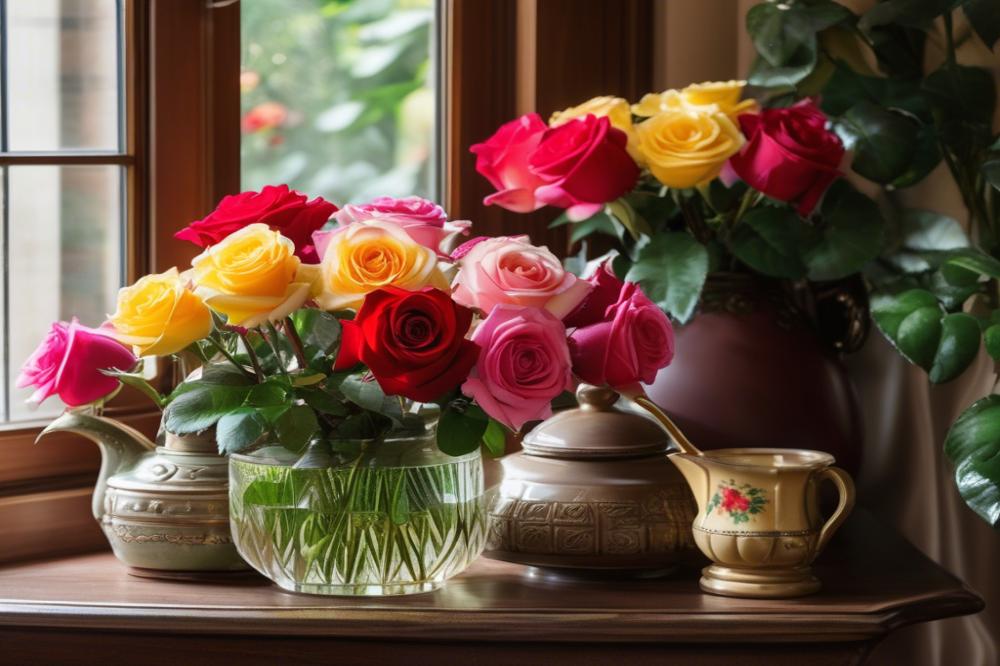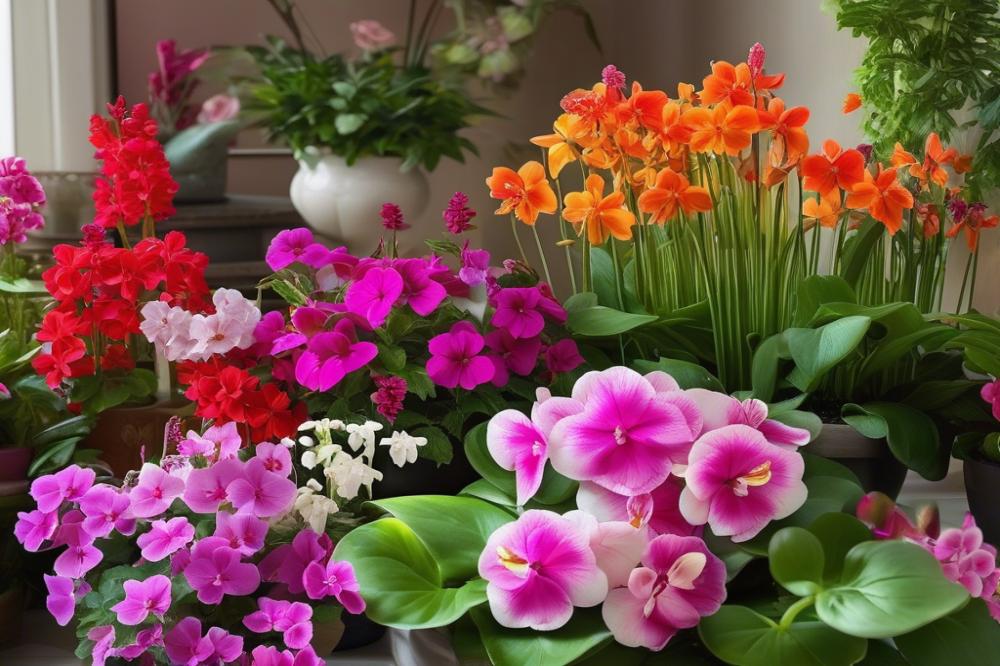Introduction
The trend of cultivating plants indoors has captured the hearts of many gardening enthusiasts. Among the different types of plants, roses stand out as a favorite for many. Their beauty, fragrance, and variety draw people in. With rose varieties ranging from tiny miniature blooms to larger, breathtaking flowers, there is a rose for every indoor space.
Indoor gardening not only beautifies your home, but it also brings numerous benefits. Planting roses indoors enhances air quality, adds warmth, and even boosts your mood. Tending to these stunning flowers promotes mental well-being. For families, nurturing plants can be an excellent bonding activity, teaching responsibility and care.
This guide will take you through all the essentials of indoor rose care. You will learn about potting roses and understanding their light requirements. Additionally, we’ll cover watering roses, fertilizing needs, and techniques for effective pest control. Pruning roses will also be discussed to keep them healthy and vibrant. By the end of this article, you will be ready to create your own indoor oasis with these beautiful blooms.
growing roses indoors

Choosing the right rose varieties is key when it comes to indoor gardening. Not all roses thrive in a confined space. Look for options known for their resilience and adaptability. Certain types are bred specifically for container gardening. Miniature and patio roses are particularly popular among indoor gardeners.
Recommendations for Suitable Indoor Rose Varieties
Consider varieties like the Miniature Rose and the Fairy Rose. These types can flourish in pots of limited size. They require less space and still deliver beautiful blooms. Another excellent choice is the Blossom Magic or the Patio Rose. Both types are renowned for their vibrant colors and pleasant fragrances.
Hybrid teas are an option as well, but they need more care. Their blooms are larger, and they offer an abundance of variety in colors. Yet, they do not fit every indoor environment. Ensure your choice aligns with the growing conditions of your home.
General Considerations for indoor gardening with Roses
Roses need specific light requirements to bloom continuously. Place them near a window that receives plenty of sunlight. Aim for at least six hours of indirect sunlight each day. If natural light is limited, consider using grow lights to boost growth.
Watering roses correctly is vital. Overwatering can lead to root rot, so check the soil before giving extra moisture. Allow the top inch of soil to dry out between waterings. A good rule of thumb is to maintain consistent moisture without waterlogging.
Proper plant care involves frequent fertilizing roses during the growing season. Use a balanced fertilizer every month. This practice ensures the plants have the necessary nutrients to thrive. Keep an eye on pests too. Regularly inspect your roses for signs of infestation.
Pruning roses is essential for healthy growth and shape. Trim off dead or yellowing leaves in early spring. This practice encourages new growth and more blooms. Maintain healthy circulation of air around the plants to minimize the risk of disease.
Finally, potting roses in the right container is crucial. Choose pots with drainage holes to prevent water accumulation. A quality potting mix can help with water retention without suffocating the roots. Remember, the effort you put into these plants will pay off when they bloom.
Basic Plant Care for Indoor Roses

Caring for indoor roses involves several essential practices. Paying attention to their light requirements is vital. Roses thrive in bright, indirect sunlight. A south-facing window often provides the best light for them. Without adequate light, plants may become leggy and fail to bloom. Rotate the pots every couple of weeks. This helps distribute light evenly to all sides.
Optimal Potting Roses for Indoor Settings
Potting roses correctly is key for their health. Choose pots that have drainage holes. This prevents water from accumulating, which can lead to root rot. When selecting a pot, consider the size. A pot that is 10 to 12 inches in diameter is a good starting point for most varieties. Larger roses might require bigger containers to accommodate their growth. Look for containers that are deep enough to allow proper root development.
Best Soil Types and Pot Sizes
Using the right soil mixture promotes healthy growth. A potting mix designed for container gardening works well. Ensure it has good drainage properties. Adding perlite or vermiculite can enhance drainage. Organic rose soil is another great option to consider. As for watering roses, keep the soil moist but not soggy. Always check the top inch of soil before adding more water. Fertilizing roses every few weeks during the growing season will encourage vibrant blooms.
Pest control is also important for maintaining indoor roses. Watch out for common pests, such as aphids and spider mites. Regularly inspecting your plants can help catch infestations early. When needed, organic insecticidal soap can effectively combat these problems. Pruning roses is essential too. This promotes airflow and removes dead blossoms. Keeping the plant tidy also encourages healthy new growth.
Light Requirements for Indoor Roses

Understanding light needs for healthy growth is crucial for anyone passionate about roses. These flowers thrive under bright light. Aim for at least six hours of direct sunlight each day. Insufficient light can lead to weak stems and fewer blooms. Therefore, choosing the right spot for your rose pots is essential.
The best locations for placing rose pots often include windowsills facing south or west. Such areas admit plenty of sunlight. If natural light is limited, consider your options carefully. Monitor the amount of light different areas receive throughout the day. Avoid places that are too dark, such as corners or rooms with only small windows.
Using grow lights can significantly aid indoor gardening, particularly during winter months or in low-light homes. These lights mimic sunlight, providing the necessary spectrum for photosynthesis. When using grow lights, place them 6 to 12 inches above your roses. Adjust the height as the plants grow to prevent burning the leaves. Aim for 12-16 hours of light per day for optimal growth.
Consider timer devices for convenience when using grow lights. These tools help maintain a consistent light schedule without extra effort. Regularly check your plants to see how they respond. If they lean towards the light, they may need more exposure. Remember, each rose variety may have slightly different requirements, so observe them closely.
By meeting the light requirements for potting roses, you set a strong foundation for successful plant care. Growth may slow without proper illumination. Always stay vigilant about adjusting the lighting setup to suit your roses’ needs. In time, your indoor roses can flourish beautifully, creating a delightful indoor space.
Watering Roses

Watering roses is pivotal for their health and growth. Understanding when and how often to water is essential for successful indoor gardening. A general rule to follow is to check the soil moisture. Water when the top inch of soil feels dry. This could be every few days or once a week, depending on conditions.
Using the right method is equally important. When watering, do so thoroughly. Pour water until it drains from the bottom of the pot. This approach ensures that the roots absorb moisture effectively. In addition, using room temperature water can help keep your plants comfortable. Cold water may shock them.
However, spotting the signs of overwatering and underwatering becomes crucial. Overwatering may manifest as yellowing leaves or a wilted appearance. Roots sitting in too much water can lead to root rot, which is harmful. Conversely, underwatering typically results in drooping leaves and dry soil. In both cases, immediate action is necessary to revive your roses.
Maintaining Humidity for Indoor Roses
Indoor environment often lacks sufficient humidity, which is why it’s important to recreate it. Many rose varieties thrive in humidity levels around 40-60%. Simple methods to raise humidity levels include misting the leaves regularly. You can also place a tray of water with pebbles near the plants. As the water evaporates, it will increase humidity around the roses.
Another effective strategy involves grouping your plants. Clustering multiple containers together creates a microclimate, raising humidity through collective transpiration. Monitor humidity levels with a hygrometer to understand better your indoor environment. A balanced climate promotes healthy blooming and lush growth.
Taking care of indoor roses extends beyond just watering. Knowledge of plant care routines, including light requirements and fertilizing roses, is essential. Always remember that each aspect of care contributes to your rose’s overall well-being. Fostering a suitable atmosphere will support their growth.
Fertilizing Roses
Regular fertilization is crucial for healthy indoor roses. It provides essential nutrients that help your plants thrive. Without proper feeding, the growth may slow down or even stop. Those beautiful blooms you desire need consistent nourishment. A well-balanced diet for your roses can make a noticeable difference.
Types of Fertilizers Suitable for Indoor Roses
When potting roses, choose the right type of fertilizer. Organic options like composted manure or fish emulsion can work wonders. These options improve soil health over time. Chemical fertilizers, such as a balanced 10-10-10 or a rose-specific mix, are also effective. They offer a quick nutrient boost that encourages growth. Always read labels before use to avoid potential damage.
Best Practices for Fertilizing Schedules
Establishing a fertilizing schedule is vital. Most indoor gardening experts recommend feeding roses every two to four weeks during the growing season. Spring and summer are crucial periods for growth and flowering. Watering roses before applying fertilizer helps prevent root burn. Ideally, ensure the soil is moist but not soggy. This careful approach will promote healthy nutrient absorption.
Adjustments may be necessary based on the rose varieties you choose. Some hybrids may require more or less feeding. Monitor your plants for signs of nutrient deficiency, like yellowing leaves. Keep an eye out for any growth issues as well. Regularly assessing your plant care regimen allows for timely adjustments.
Lastly, don’t forget about pest control. Fertilizing roses can inadvertently attract pests if not managed carefully. Always inspect your plants before and after fertilization to catch any issues early. Pruning roses can also aid in managing growth and enhancing air circulation. Container gardening offers more control, making it easier to provide the care your roses need.
Pest Control for Indoor Roses
Common Pests That Affect Indoor Roses
Indoor roses can fall victim to several pests. Aphids are tiny insects that suck the sap from the leaves. They often congregate on new growth. Spider mites, although not insects, can cause a lot of trouble too. These small critters leave webs on the underbelly of leaves. Whiteflies might also invade your plants, leading to further stress. Each of these pests poses a threat to plant health and vitality.
Organic and Chemical Pest Control Methods
Using organic methods can be effective and safer for your indoor environment. Neem oil acts as a natural insecticide that disrupts pest life cycles. Another option is insecticidal soap, which removes pests on contact. For those who prefer chemical products, look for treatments designed specifically for roses. Follow the manufacturer’s instructions closely for safe application. Alternatively, introducing beneficial insects like ladybugs can help control pest populations without harmful chemicals.
Prevention Strategies for a Healthy Indoor Garden
Preventing pests begins with good practices during potting roses. Choose high-quality soil that is free from bugs and diseases. Regular watering roses while allowing the soil to dry slightly between sessions helps maintain healthy roots. Make the right choices when selecting rose varieties; some are more resistant to pests than others. Pruning roses regularly encourages healthy air circulation and reduces the chances of infestations. Consider placing your plants in bright locations that meet their light requirements. Such care reduces stress on the plants and makes them less appealing to pests. Always inspect new plants before bringing them inside, as they may carry hidden pests. With proactive measures and attentive plant care, you can create a thriving indoor garden.
Pruning Roses
Pruning is essential for the health of your indoor roses. It helps remove dead or diseased wood. This process also encourages new growth and blooms. Without pruning, plants can become overgrown and weak. Roses require proper shaping to thrive in container gardening. Regularly maintaining their shape leads to a fuller and more vibrant plant. A well-pruned rose will also attract fewer pests, making pest control easier.
When and How to Prune Indoor Roses
Timing is crucial for pruning roses. Generally, the best time is in early spring before the new growth starts. However, if you notice any dead or damaged stems, address them immediately. Start by identifying the stems that need attention. Cut back about one-third of the total height for healthier growth. Aim for a slanted cut above a leaf node. This approach encourages strong new growth in the correct direction. Avoid cutting too close to the node, or you may hinder future growth.
Tools Required for Effective Pruning
Having the right tools makes pruning easier. Sharp pruning shears are a must. These will make clean cuts and prevent damaging the plant. A small saw may be necessary for thicker stems. Don’t forget to wear gloves for hand protection. After pruning, clean your tools with rubbing alcohol to prevent disease spread. Always ensure your shears are disinfected to maintain the health of your roses.
Final Thoughts on growing roses indoors
In summary, we’ve explored the essential steps to cultivate beautiful roses in your home. First, choose the right rose varieties that suit your indoor environment. Providing adequate light is crucial, so remember to place your plants near a window or use grow lights. Proper watering and drainage will help your roses thrive, while the right soil mix ensures healthy growth. Consistent maintenance, including regular feeding and pruning, keeps your plants lively and vibrant.
Starting your journey with indoor gardening can be both exciting and rewarding. Imagine enjoying fresh blooms right from your living room! It’s a fulfilling way to express creativity and bring a touch of nature inside. Don’t hesitate to experiment with different types of roses to find what works best for you.
As you embark on this adventure, keep a few tips in mind. Always monitor your roses for pests and diseases. A little attention goes a long way in preventing problems. Also, never underestimate the power of patience; roses can take time to flourish fully. With care and dedication, you can succeed in creating a stunning display.
So why wait? Grab some pots, choose your favorite roses, and start this new endeavor today. Your home will thank you with an explosion of color and fragrance. Happy growing!



